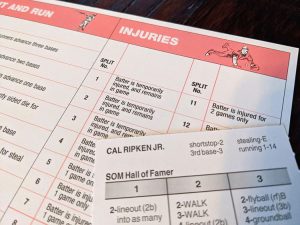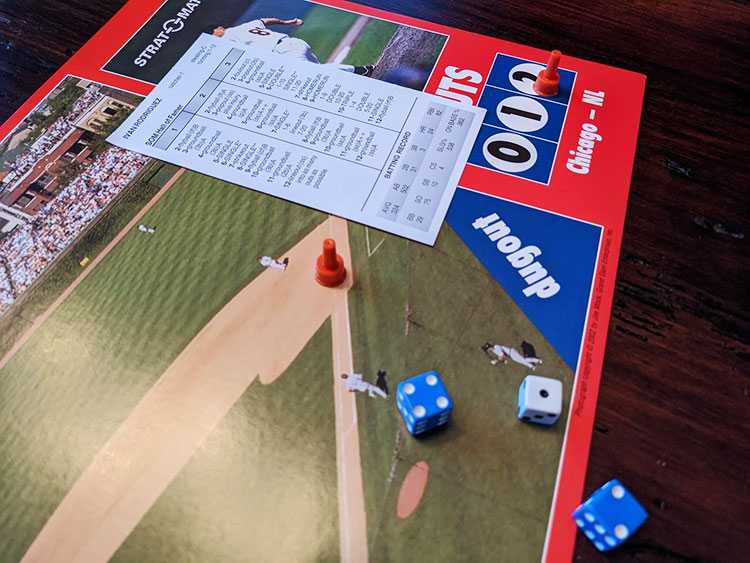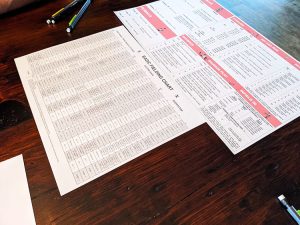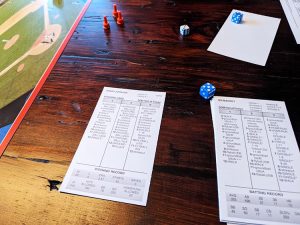 The smell of cut grass, the crack of the bat and the slap of the baseball on leather…the thought is enough to get any baseball fan through the wintertime. With Strat-O-Matic Baseball, the classic baseball managerial simulation, that feeling can be yours any time, if you feel like substituting with the smell of a freshly sharpened pencil or the sound of dice tumbling across the tabletop. Either way, Strat-O-Matic promises to transport you to your own personal field of dreams, allowing you to manage players from years past as they engage in America’s pastime. Does this game hit a grand slam, or does it strike out?
The smell of cut grass, the crack of the bat and the slap of the baseball on leather…the thought is enough to get any baseball fan through the wintertime. With Strat-O-Matic Baseball, the classic baseball managerial simulation, that feeling can be yours any time, if you feel like substituting with the smell of a freshly sharpened pencil or the sound of dice tumbling across the tabletop. Either way, Strat-O-Matic promises to transport you to your own personal field of dreams, allowing you to manage players from years past as they engage in America’s pastime. Does this game hit a grand slam, or does it strike out?
Gameplay Overview

As managers do in a live game of baseball, each player in Strat-O-Matic chooses their position players and arranges them in a batting order. An at-bat consists of referencing the player card of the batter and the player card of the pitcher. The at-bat player rolls three d6, which will determine the outcome of the at-bat. The first die reveals which player card will be referenced (1-3 for columns on the batter card, 4-6 for the pitcher) and the sum of the other two dice determines the actual outcome of the play. A wide range of results are possible, dependent on runners on base, offensive play calls for stealing, sacrificing, hit & run, as well as defensive alignments for double-play depth, infield in, shifts and the like.
The Basic rules involve rules and play outcomes, with limited decisions regarding play calls and defensive alignments. The Advanced rules introduce different possible outcomes for batters facing righty and lefty pitchers, as well as more complicated rules for the results of plays that take fielding ability, baserunning acumen and speed into account. In the Super-Advanced rules, even more detail and complexity are integrated, with specialized rules for defensive shifts, weather and stadium crowd effects, player fatigue all just creating more layers of simulation.

Game Experience
There is a prevailing belief that Strat-O-Matic is the “Dungeons and Dragons of baseball” and this is definitely an apt analogy, especially if you have any sort of experience playing pre-d20 D&D. Each roll of the dice can send you hunting through multiple tables that send you to other tables to determine just what the result of the play is. A fly-ball to right field may result in an out, but then you must check your right-fielder’s arm strength compared to your baserunner’s speed, and then check another table to see about weather effects. Like checking THAC0 tables, Strat-O-Matic has a grid to reference for every possible eventuality and situation, giving players as little or as much detail their gameplay experience.

The amount of cross-checking and referencing and data mining is related to the complexity of the ruleset you decide to play with. The Basic game is created for any players to sit down, open the box, quickly set up their teams and start rolling. The Advanced and Super-Advanced rules, while building on the previous levels, add more complexity (and more time) for each play to resolve. This complexity leads to greater detail of the simulation, allowing you to get extremely detailed in the moves you make in managing your team both during and between games. This is definitely a game that rewards players that want to immerse themselves in the experience, no matter what level of rules you choose, and it is of no surprise that it has a die-hard cult following, including some current and retired MLB players.
The experience of playing a single game of Strat-O-Matic versus a series or a whole season is analogous to the feeling of running through a D&D one-shot compared to an entire campaign. Both will give you the fun of playing the game, but the long-term planning and management, storyline development and building of experiences that result from playing through many games provide a deeper sense of enjoyment. While playing through a 162 game season is hard for any gaming group (disclaimer: we did not play 162 games), we found that playing through a 7-game series is perfect for a long afternoon gaming session, at the Basic level of complexity. While we have read that experienced players can get through an Advanced rules game in 30 minutes, that was definitely not our experience, but we still enjoyed it.

With this version of Strat-O-Matic being the 80th Anniversary Hall of Fame edition, it contains cards for every player in the MLB Hall of Fame. Being baseball fans, we were excited to be able to assemble teams with some of the greatest players to have ever played the sport across all eras of the game. The situations of Mickey Mantle going up to bat against Greg Maddux or fielding an outfield of Ralph Kiner, Ken Griffey Jr., and Babe Ruth are all possible using this set of cards. We look forward to when Strat-O-Matic releases the 2019 player cards, so we can pilot our beloved Yankees to the World Series win that was theirs (in our dreams.)
Final Thoughts:
Strat-O-Matic is a worthwhile experience if you are a fan of baseball, made easier by previous experience in playing role-playing games or wargames that require a good deal of rules referencing. The 80th Hall of Fame Anniversary cards give you the ability to mix-and-match players from across all eras, putting together players you only have read about with the ballplayers you grew up with. Diehards can work to make the time investment to play an entire season, but a short series will be more than enough to sate your baseball needs until pitchers and catchers report.
Final Score: 3 Stars – A solid simulation, with as little or as much detail as you like.
 Hits:
Hits:
• Basic rules are easy to learn and get the game running quickly
• Game can be as complicated as you desire based on level of simulation detail
• Players across all eras of the game
Misses:
• Advanced and Super-Advanced versions are very time intensive
• Tremendous time investment needed for an entire season of play





















